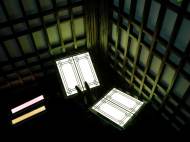Light bulb wars – South Korea makes a move with OLED
 Over 50% of the world light bulb market is covered by old, energetically and environmentally unfriendly incandescent light bulbs. EU energy ministers met in Luxembourg back in 2008 in order to give a final approval to an EU-wide ban on incandescent light bulbs that should begin in 2010. There are many alternative technologies as white-light LEDs, plasma light bulbs, CFL’s etc. Organic light emitting diodes (OLEDs) have an impressive energy efficiency, flat form and incandescent brightness – many virtues which should ensure their prosperity in the next generation of lighting.
Over 50% of the world light bulb market is covered by old, energetically and environmentally unfriendly incandescent light bulbs. EU energy ministers met in Luxembourg back in 2008 in order to give a final approval to an EU-wide ban on incandescent light bulbs that should begin in 2010. There are many alternative technologies as white-light LEDs, plasma light bulbs, CFL’s etc. Organic light emitting diodes (OLEDs) have an impressive energy efficiency, flat form and incandescent brightness – many virtues which should ensure their prosperity in the next generation of lighting.
Their most severe problem of OLEDs is related to the lifespan of the organic materials used in OLEDs has been beaten by South Korea’s Electronics and Telecommunications Research Institute (ETRI). They have developed a white OLED lamp that has a lifetime of 10,000 hours – 20 percent longer than existing fluorescent lamps.
The new OLED can emit light from flat surfaces, has high energy efficiency that can help reduce greenhouse gas emissions, and are more eco-friendly since they do not use mercury in the manufacturing process like incandescent and fluorescent bulbs.
The ETRI-developed lamp boasts an efficiency of 70 lumens per watt. As a reference, the typical incandescent lamps have an efficiency of just 15 lumens per watt. Apart from being more than four times more efficient, the OLED lamp is also more environmentally friendly when it has burned out because, as previously noted, it contains no mercury.
According to ETRI, “there are currently no commercial OLEDs in production, but they are expected to make an appearance in late 2010, with full scale production to begin around 2015 when they may start to replace conventional light sources.”
ETRI believes its development of the OLED lamp is important if South Korea wants a share of the global OLED lighting market, which is expected to be worth about 2.4 billion US dollars by 2015.









Leave your response!